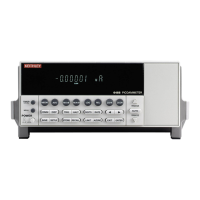1-10 Getting Started Model 6485 Picoammeter Instruction Manual
6 RS-232
Female DB-9 connector for RS-232 operation. Use a straight-through (not null modem) DB-9 shielded
cable.
7 IEEE-488
Connector for IEEE-488 (GPIB) operation. Use a shielded cable, such as Models
7007-1 and 7007-2.
8 Power module
Contains the AC line receptacle and power line fuse. The instrument can be configured for line volt-
ages of 115V and 230VAC (nominal) at line frequencies of 50 or 60Hz automatically and over the bus.
Changing line voltages requires changing fuses.
Analog output
The Model 6485 has an analog output on the rear panel. The ANALOG OUT provides a
scaled, inverting ±2V output. A full-scale reading corresponds to ±2V output.
WARNING The maximum safe voltage between picoammeter LO and chassis
ground (common mode voltage) is 42V. The Model 6485 does not inter-
nally limit the LO to chassis voltage. Exceeding 42V can create a shock
hazard.
CAUTION The LO to chassis breakdown voltage is 500V. Exceeding this voltage
may cause damage to the instrument.
Connecting COMMON or ANALOG OUT to earth while floating the
input may damage the instrument.
Connections for using this output are shown in Figure 1-3. For a full-scale input (i.e. 2mA
on the 2mA range), the output will be -2V. Example analog outputs are listed in Table 1-1.
The 2V analog output signal is not corrected during calibration. Gain errors of up to 3%
may appear at this output, depending on range.
The output impedance is 1kΩ. To minimize the effects of loading, the input impedance of
the device connected to the ANALOG OUT should be as high as possible. For example,
for a device that has an input impedance of 10MΩ, the error due to loading will be approx-
imately 0.01%. High capacitance connected to the analog output will increase the rise
time.
Rel and the result of mX+b, m/X+b, or LOG have no affect on the analog output. The 2V
analog output is scaled only to the actual input.

